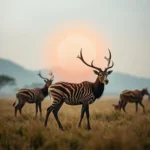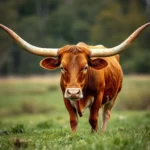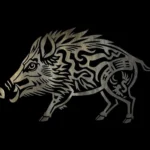The Significance of Nilgai: Symbolism and Spiritual Meaning
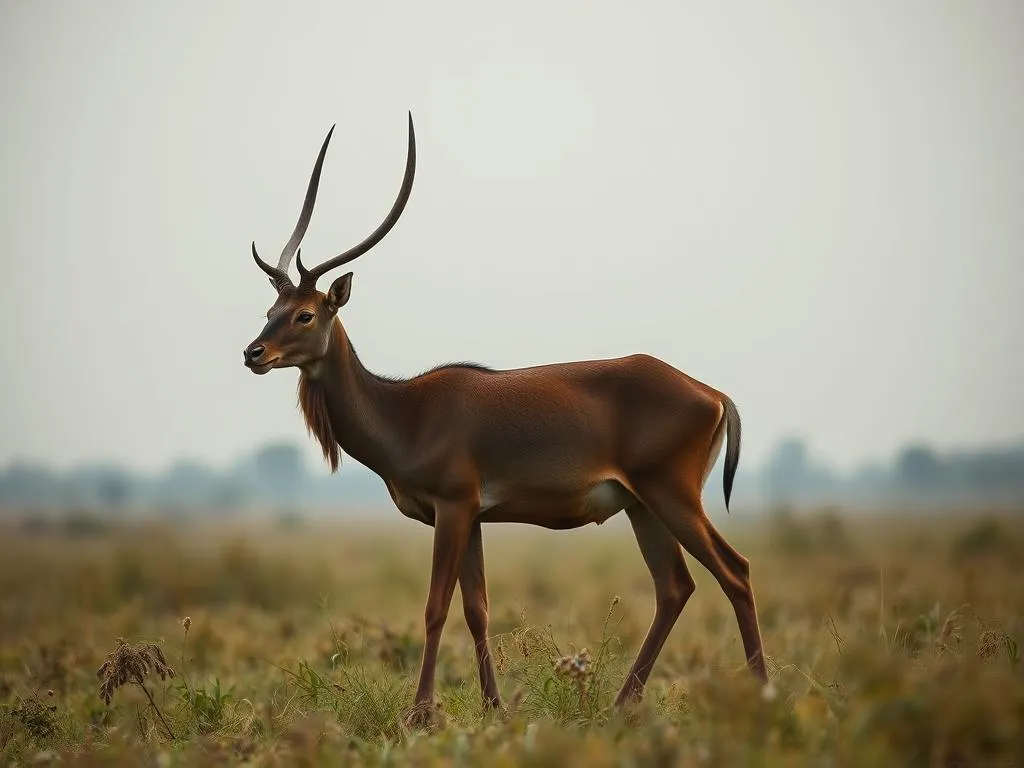
Disclaimer: Some images on this website are AI-generated artworks and may not accurately represent real animals.
Understanding the Nilgai
Overview of the Nilgai
The nilgai, or blue bull, is the largest antelope species in Asia, primarily found in the Indian subcontinent. Known scientifically as Boselaphus tragocamelus, this remarkable creature is characterized by its unique bluish-gray coat, long legs, and a distinctive white facial marking. Adult males, larger than females, can weigh between 220 to 400 pounds and stand up to 4.5 feet tall at the shoulders.
Nilgais are typically found in grasslands, scrub forests, and agricultural fields, thriving in varied terrains. They are herbivorous and primarily feed on grasses, leaves, and agricultural crops, showcasing their adaptability to human-altered landscapes. Their social behavior is intriguing; they often form small herds led by a dominant male, fostering social bonds and cooperative living.
Cultural Significance
The nilgai holds a prominent place in the cultural fabric of India. Revered in various religious and cultural narratives, this animal is often viewed as a symbol of strength and resilience. In some regions, the nilgai is associated with fertility and prosperity, believed to bring good fortune to agricultural communities.
Historically, the nilgai has been depicted in folklore and traditional art, reflecting its significance in local traditions. The animal’s presence in rural settings has made it an integral part of daily life, influencing local customs, festivals, and even cuisine. In certain communities, the nilgai is considered sacred, emphasizing the deep-rooted connection between humans and nature.
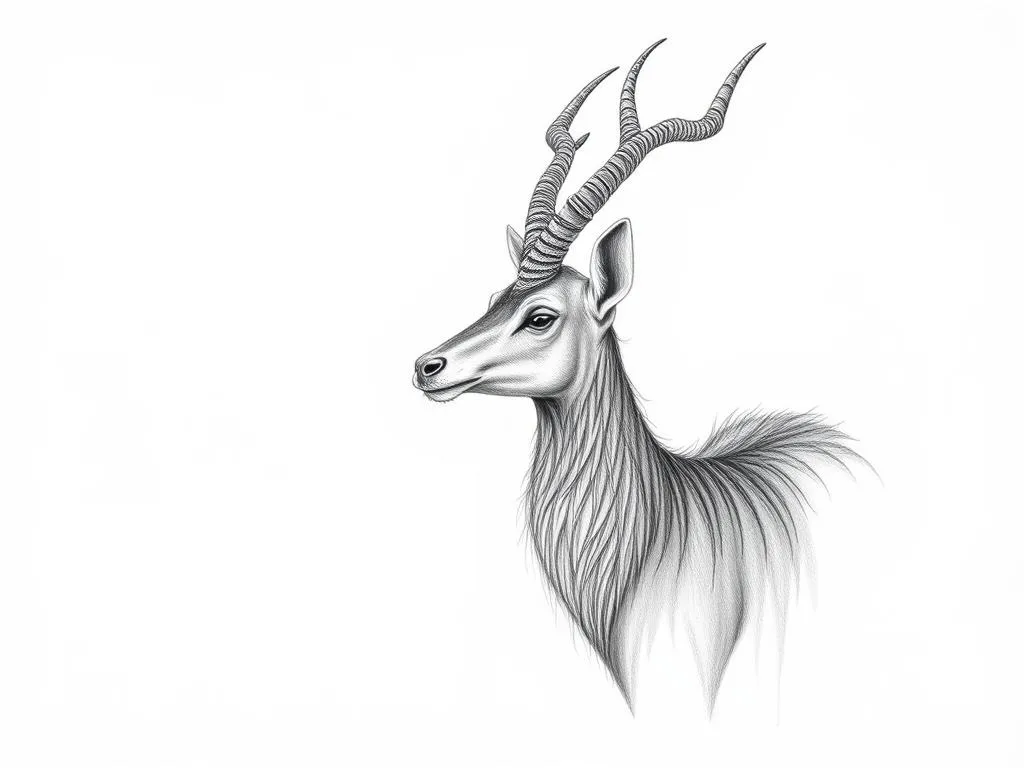
Symbolism & Spiritual Meaning
Adaptability and Resilience
One of the most profound aspects of nilgai symbolism is its representation of adaptability and resilience. The nilgai’s ability to thrive in diverse environments, from lush grasslands to arid regions, serves as a powerful reminder of the importance of flexibility in our lives.
In facing challenges, the nilgai exemplifies how adaptability can lead to survival and success. This symbolism encourages individuals to embrace change, adapt to new circumstances, and remain steadfast in their pursuits. The nilgai teaches us that resilience is not merely about enduring hardships but also about evolving and flourishing despite them.
Gentleness and Grace
The nilgai’s calm demeanor and graceful movements further enhance its symbolic representation of peace and gentleness. Observing a nilgai as it navigates its habitat reveals a sense of tranquility and poise. This animal embodies the idea that strength can coexist with gentleness, offering a lesson in balance.
In a world often marked by chaos and uncertainty, the nilgai inspires us to cultivate inner peace and grace in our interactions. By embracing gentleness, we can foster understanding and compassion, building stronger relationships and communities.
Connection to Nature
As a vital component of its ecosystem, the nilgai symbolizes harmony and balance in nature. Its role as a herbivore helps maintain the health of grasslands, contributing to biodiversity and ecological stability. The nilgai’s presence serves as a reminder of the interconnectedness of all life forms and the importance of preserving our natural environments.
This symbolism encourages individuals to reflect on their relationship with nature and the responsibility that comes with it. By protecting wildlife and their habitats, we honor the delicate balance that sustains life on Earth, fostering a sense of stewardship and awareness.
Nilgai in Dreams
Interpreting Nilgai Dreams
Dreams featuring the nilgai can offer profound insights into personal challenges and growth. The appearance of this majestic creature in dreams may signify a need for adaptability and resilience in waking life. It can represent an upcoming change or a challenge that requires a gentle yet strong approach.
When we encounter a nilgai in our dreams, it may also reflect our desire for peace and tranquility. The symbolism of the nilgai encourages dreamers to embrace their inner strength while nurturing a calm and gentle demeanor in dealing with life’s obstacles.
Common Themes in Nilgai Dreams
Dreams involving the nilgai often encompass various themes, reflecting the animal’s symbolism and meaning. Below is a table outlining some common themes associated with nilgai dreams:
| Theme | Interpretation |
|---|---|
| Freedom | A desire to break free from constraints or limitations. |
| Exploration | An urge to discover new opportunities or experiences. |
| Tranquility | A need for inner peace amidst chaos. |
| Adaptability | The ability to adjust and thrive in changing circumstances. |
| Strength | The importance of resilience in overcoming challenges. |
Understanding these themes can provide valuable insights into our subconscious and guide us in navigating our waking lives.
Modern Interpretations
Nilgai in Art and Literature
The nilgai has found its place in modern art and literature, serving as a symbol of various qualities and themes. Contemporary artists often depict the nilgai to highlight its grace and beauty, reflecting a connection to nature and the importance of wildlife conservation.
In literature, the nilgai is sometimes used as a metaphor for resilience and adaptability. Authors draw upon the animal’s characteristics to illustrate the struggles and triumphs of human experiences. As a symbol, the nilgai serves to remind readers of the profound lessons that nature can impart.
Conservation and Symbolism
In recent years, the nilgai has become a focal point in conservation efforts across India. Its symbolism extends to environmental awareness, representing the need to protect wildlife and their habitats. The challenges faced by the nilgai, such as habitat loss and poaching, highlight the broader issues of biodiversity and ecosystem health.
Conservation campaigns often use the nilgai as a charismatic emblem to raise awareness about the importance of wildlife protection. By aligning the nilgai with conservation efforts, organizations seek to inspire individuals to take action in preserving our natural world.
Key Takeaways
Summary of Nilgai Symbolism
To encapsulate the significance of the nilgai, here are the key symbolic meanings associated with this remarkable creature:
- Adaptability: Embracing change and thriving in diverse environments.
- Resilience: Overcoming challenges with strength and determination.
- Gentleness: Promoting peace and grace in interactions.
- Connection to Nature: Recognizing the interdependence of life forms and the importance of ecological balance.
Personal Reflection
As you reflect on the symbolism of the nilgai, consider how its qualities resonate with your own life experiences. Embrace the lessons of adaptability, resilience, and gentleness as guiding principles. Each of us can find ways to incorporate these values into our daily lives and interactions.
- Think about areas in your life where you can be more adaptable.
- Reflect on how you can cultivate resilience in the face of adversity.
- Consider how gentleness can enhance your relationships and community connections.
- Acknowledge your role in preserving the balance of nature and wildlife.
Conclusion
Embracing Nilgai Wisdom
The symbolism of the nilgai offers profound insights that can inspire individuals to embody qualities of resilience, grace, and harmony. By understanding and embracing these lessons, we can navigate the complexities of life with a renewed sense of purpose and clarity.
In a world that often demands strength and assertiveness, the nilgai teaches us that gentleness and adaptability are equally powerful. As we reflect on the wisdom of this majestic creature, let us strive to nurture these qualities within ourselves and foster a deeper connection to nature and those around us. By doing so, we honor the spirit of the nilgai and the rich tapestry of life it represents.


